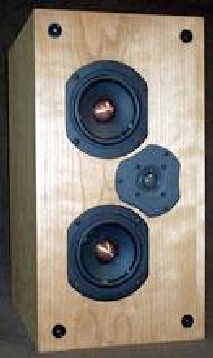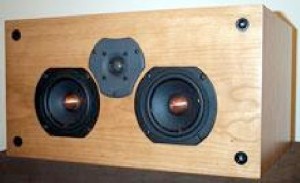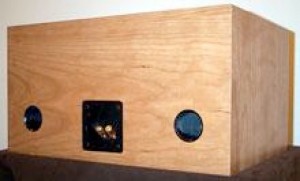Frequency response (+/- 3db 50Hz to 20kHz)
8 ohm nominal impedance
4th order (cascaded 2nd order) crossover at 5kHz
Quality crossover parts including air core inductors and film and foil polypropylene capacitors
Oxygen free stranded copper internal wiring
All soldered connections
External dimensions: Upright – 17″H x 9″W x 12″D; Horizontal – 9″H x 17″W x 12″D 100 watt peak power handling 88 db/1w sensitivity
Magnetically shielded for use near televisions or monitors
Grade A real wood veneer inside and out to prevent warping.
Driver 4.5″ Diameter Treated paper cone Rubber surround Copper phase plug Cast frame
Patent pending XBL^2 motor design
Long throw voice coil
Tweeter 20mm diameter
Soft Dome
Nylon resin frame with vibration suppression
Low diffraction face plate
Ultra high frequency response
Pricing: $279 each or $549 per pair
Which piece of equipment in the audio chain has the most difficult task? Is it the CD player? Imagine the complexity of reading all the bits off a disc and keeping them in proper order. What about the turntable? Who must battle
the enemies of vibration, friction, and inertia? Let us not forget about the speaker wire and interconnects. The cables get the thankless job of transferring the amplifier’s final output. Quite often they have to cover long distances, while having a minimal part of the audio budget spent on them. My vote goes to the loudspeaker. This component gets the daunting task of reproducing the complex nature of an orchestra, and yet it still must be capable of rendering the subtle nuances of the human voice.
I am continually amazed at the ability of a good loudspeaker. It is hard to believe that a speaker can reproduce the jump factor of Count Basie’s Big Band, and yet captures the beauty of Allison Krause’s vocal style. It is one thing when a state of the art loudspeaker can accomplish these tasks, but is it realistic to ask a modestly priced loudspeaker to accomplish the same things? Very few inexpensive speakers have the ability to convincingly recreate a musical performance. This is why speakers like the Rosa, from Alegria Audio, are important to the audio community. Will the Rosa trick you into believing that you are hearing the latest flagship model from Merlin or ProAc? Well, of course not. What these speakers do succeed at is allowing the listener to have an emotional connection to the music. This is very rare characteristic in the budget speaker niche where the Rosa’s reside.
Alegria Audio Rosa speakers review
Residing in the rainy lands of SeaTac, Washington is Alegria Audio. This manufacturer can be described as an “audio boutique” company. Over the years, I have found myself consistently drawn to the offerings of smaller audio companies because of the innovative products that they produce. For instance, John Bau performed groundbreaking work in speaker driver time alignment with Spica Audio. Timothy Forman, who owns Alegria Audio, may not be breaking hallowed ground, as John once did, but he has created a speaker that is very easy to get excited about. When I spoke with Tim about his company, it became evident that he has a genuine passion for designing and building loudspeakers. The Rosa is a two way D’Appolito design, which features two fourinch mid bass drivers, and a 20mm soft dome tweeter. The cabinet design is a bass reflex with two rear facing ports. The mid bass driver is a stellar unit that would normally be found in far more expensive speakers than the Rosa. The WR125ST is manufactured by Creative Sound Solutions, although it is designed by Dan Wiggins of Adire Audio. This speaker packs a lot of innovative technology in its diminutive frame. Upon close examination of the WR125ST you will find a treated paper cone, rubber surround, copper phase plug, and cast basket. While all these features are important to a quality driver, the heart of this unit is the XBL^2 voice coil. Dan Wiggins has created a design that allows the driver to avoid compression losses over the excursion range of the speaker. A conventional driver output level can have significant losses as it approaches the limits of its travel. This innovative voice coil structure minimizes the effects of driver compression and gives a smaller diaphragm the ability to move large amounts of air. Not only does this translate into deeper bass response, but also improved midrange reproduction.
The tweeter is a 20mm textile dome developed by Fostex. It was chosen for its even frequency response, and a distinctive faceplate that allows Tim to get the tweeter very close to the midbass drivers. Inside the cabinet resides a very nice 4th order crossover composed of high quality air core inductors and polypropelene capacitors. All of these high quality parts are housed in a classy looking cabinet constructed out of real wood veneer MDF. The cherry finish on the review pair is quite attractive, with a conservative tone to its appearance. The Alegria Audio Rosa is a dual application speaker and can be used as a main speaker in a two-channel system, or as a center channel. The offset tweeter design allows the user to place the Rosa at several different heights when being employed as a center channel speaker. For the context of this review, the Rosa will be used as main speakers in a twochannel system.
The final listening position for the Rosa Speakers was 32 inches off the rear wall. They resided on 22 inch tall Skylan stands. A pair of Electra Print 300DRD monoblocks fulfilled the amplification duties. While the Electra Print PVA pre amp took care of signal routing duties, and provided that critical first level of gain. A modified Sony 595 CD player took care of the job of spinning those shiny silver platters. Tara Labs Air 3 and RSC Master speaker were used to make those critical connections between components. Finally, an Audio Pro Avantek subwoofer was pressed into service to determine how well the Rosa can be turned into a full range system.
The Rosa is a lively speaker that engages the listener is a way that makes listening to music an active experience. I firmly believe that the WR125ST mid bass driver is the primary reason why this speaker performs so well. The Rosa’s ability to portray voices in a believable manner is uncanny. Over the years I have encountered only a handful of speakers that can perform at the same level as the Rosa in this regard. In Ellis Paul’s “Conversation With A Ghost” [Say Something; Black Wolf Records 9653-2] a delicate vocal performance by Ellis and Patty Griffin is rendered in an ethereal manner that floats over Paul’s delicate guitar playing. The Rosa’s are capable of displaying the sharp contrast between Ellis’s low and breathy vocal style, and the rich vibrato in Patty’s passages. The interplay between both artists’ vocal styles can be glossed over by a less capable speaker. But the Rosa comes through with flying colors in this regard. Its ability to reproduce the human voice in a believable manner makes this speaker a real gem. I can not think of a speaker that falls into the $500 price bracket that can come close to the quality of vocal reproduction that the Rosa is capable of.
Reproducing the scale, and the raw power of a large ensemble is a task that is better suited to large speakers. Floor standing speakers with bass drivers the size of dinner plates have a significant advantage in the department of bass response. Speakers with larger surface area are capable of displacing more air, which translates into deeper bass, and greater dynamic range. However, the XBL^2 design allows the Rosa to achieve a level of performance in the lower registers that other bookshelf speakers are hard-pressed to match. The lower end of the Rosa measures down to 50 hertz, which means they are capable of reproducing the majority of bass information on a recording. I found the Rosas bass performance to be surprisingly good. With a variety of material these speakers reproduced bass that is articulate and extremely detailed. For instance, Battle Royal [Duke Ellington Meets Count Basie; SACD CS65571] is a historic recording of big band music that features the two greatest bands of jazz music. In the opening track the bass player Freddie Green lays down a furious riff to anchor the piece. The Rosa’s reproduces Green’s performance with excellent clarity and speed. After two short piano segments that introduce the melody, the rest of the brass instruments make their presence known. Now the music kicks into high gear, and the power of two full bands is unleashed. To their credit the Rosas are unfazed by the demands placed upon them. For instance, the trombones and trumpets have superb tonal balance and dynamic range. Even when the music reaches its crescendo, the Rosa’s maintain their composure and never sound strained or compressed. I have to say I am pleasantly surprised at how well a pair of four and half-inch drives are able to reproduce every facet of this historic performance.
I have to admit to being a tweeter junkie. Any unit that employs exotic materials, or an unusual design will grab my attention. Several of the speakers I have owned have used metal dome, or ribbon tweeters. However the Rosa’s contain a soft dome from Fostex that I thoroughly enjoy. The Fostex FT207D, which is a 20mmm textile dome with a unique triangular faceplate. The faceplate design allows for closer placement to the midbass drivers. This improved driver integration is responsible for the Rosa’s superb imaging abilities. While soft dome tweeters can be hard to get excited about, the Fostex is a classic example of a well-designed driver. It has a smooth and even frequency response that is very pleasant to listen to. While state of the art tweeters are capable of extracting finer levels of detail, the Fostex performs at a level that belies its affordable price.
In an alternate arrangement of Hotel California [Hell Freezes Over; Geffen GEFD-24725] the Rosa’s high frequency abilities are brought to the forefront. In this acoustic version of an Eagles classic, Don Felder creates a Flamenco style riff to introduce the song. Also the standard drum kit is exchanged for one with a Latin flavor. The Rosa’s reproduction of Felder’s guitar work is very convincing. But what is worth noting is how the notes decay in such a realistic manner. I have encountered very few speakers that have the ability to capture an instruments decay characteristics like the Rosa’s can. In those opening notes to Hotel California, the individual notes appear to hang in mid air, and then resolve into nothingness just before the following note is played. It is a strikingly eerie presentation that can send chills down your spine. Tim Stinson should be proud of how well he has implemented this tweeter design in the Rosa’s.
These speakers are a dual application design. Quite often the Rosa’s will be used in a home theater set up. This means that a subwoofer will often be mated to them. So I took one evening to listen to them in conjunction with an Audio Pro subwoofer. I still ran the Rosa’s full range, but rolled the Avantek subwoofer in to fill out the lowest registers. I set the crossover at 50 hertz, and then spent a couple of hours adjusting it’s output level. Integrating subwoofers can be a maddening task. In this case it was very simple to match the Rosa’s and Audio Pro up. Within one evening, I had a seamless integration between the two units. The addition of the subwoofer turned the Rosa’s into a true full range speaker capable of handling the demands of a wide range of music.
Conclusions about Alegria Audio Rosa speakers
The Rosa’s are a value packed speaker. I am not sure how Tim Stinson can sell these for $549 a pair. I took a moment to look up the cost of individual components on the net. The WR125ST driver sells for $50 apiece, and the Fostex FT207D for $40 each. So a pair of Rosa speakers contain $280 worth of drivers. Then you have to add in a real wood veneer cabinet, and a high quality crossover network. But creating a good speaker is just a matter of assembling a group of high quality parts. Tim performed extensive computer modeling in the initial design stage of the Rosa’s. Then he put his measurement tools away, and made final design adjustments by ear. While there are trade-offs in all speaker designs, it is apparent that Tim has made these choices wisely. The Rosas are a speaker capable of extracting a high level of detail from a recording without dissecting the music. I found my time with the Rosa’s to be very enjoyable, and can recommend them to anyone looking for a moderately priced speaker.


